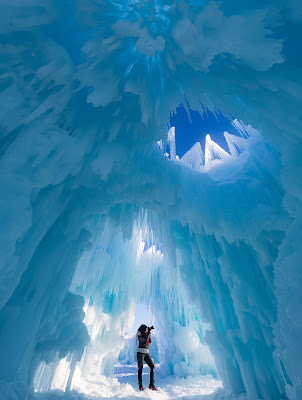Students enrolled in the MIT Sloan Master of Business Analytics program are prepared for employment that includes using and managing cutting-edge data science to address important business challenges.
Utilizing artwork to learn about the brain
The connection between neurobiology and art is really powerful. Neuroscientists are interested in learning how the brain functions.
How does the brain interpret incoming information?
Then, in the studio, we apply that scientific knowledge through practice. The development of each student's unique works of art for exhibition begins during the semester. Each pupil chooses the aspect of perception that appeals to them.
And by their own creative exploration, they will enquire into it. The spectator may see how crucial visual signals are for understanding the environment in my work. To make something disappear, I intended to suspend it in the Ganzfeld, a place where everything is the same color and brightness.
It was amazing how much utter darkness and total brightness are alike.
For your brain to interpret what it is seeing, it needs to be able to recognize details like corners, parallax, and reflections. If not, it appears as though you are staring into complete obscurity. A peculiar method is an art. We produce stuff for the public to view.
This is how art is utilized throughout the course. not to support a scientific hypothesis. but as a supporter and occasionally a trigger for understanding well about nature of sight.
What knowledge is required for the brain to recognize objects in the surrounding environment?
They have effectively reduced their sensory experience to how they can sense that which they understand as artists. We hope that all of the pupils in this class understand what it is that they are attempting to portray. The vision is therefore very intricate.
Additionally, I have knowledge of this from earlier neuroscience courses. But what makes this session so special is that you can actually slow down the process of your own visual processing by using art. Therefore, you actually get to feel yourself seeing the world while you're doing hands-on labor.
The technique we create artwork is really particular. With materials and light, we make things. After that, we observe our creations and gain knowledge from them. Art thus has the power to explore the depths of perceptual experience. And we assist the kids in becoming aware of that process. There are two complementary parts to the class. A seminar and a studio.
We will discuss our present knowledge of visual neuroscience in the seminar.
Informatics for Our Upcoming Climate
The problem is that, although there is a lot of information about climate change, it isn't always presented in a way that users can use it in a way that reflects the most cutting-edge computational work. To make our climate models more reliable, better fit the data, and manage uncertainty, they must be improved.
There are numerous opportunities to deepen our understanding of the city. We want to develop a platform that enables stakeholder communities to choose wisely based on the most recent scientific findings. A climate model essentially uses a set of equations to predict how the climate would change in response to certain scenarios. For instance, they might tell you whether a train is likely to arrive tomorrow, and you can use that information to make plans.
If the likelihood is 90%, you can choose not to trek, or if it's 10%, you can choose to take a significant risk. Maybe all you bring is an umbrella. We don't have the same type of system for simulating climate change where the climatologists are quite challenging to use and aren't specifically designed for use by stakeholders. They must make choices. The distinctive feature of our strategy in comparison to some of the available climate data is that those outputs will be incredibly flexible to deliver on this promise.
You have realized the need to bring together members of various communities. Teams from around the institution collaborate very closely with businesses. To ensure that the findings of the climatic information are the most pertinent and practical, we will collaborate with individuals who are using them locally.
Mit is at the cutting edge of computational technology, therefore it should close that gap and enable engagement between participants and the climate research community to produce tools that can be used for decision-making. We want to show that you can build that kind of software and what kind of infrastructure is needed to do it.
We are certain that we can make the necessary breakthroughs since we have the necessary personnel in place, the backing of mit, and the capacity to do so.
With Crystal Critters, MIT Technologies
The researchers discovered that by adding a temperature gradient to the surface, which would cause rolling and enable them to remove the structures once evaporating is complete, they might take advantage of the temperate-reliant growth. Otherwise, a buildup of these impurities over time affects heat transfer efficiency, clogs pipes, and generally leads to material deterioration and degradation.
Because of this phenomenon, it would be conceivable to use salty or brackish water for evaporative cooling in power plants without the need for any costly pretreatment.
A group of MIT scientists has discovered that the crystal formations that develop when salty ice melts from a heated highly hydrophobic surface eventually self-eject off the ground.
A crystal globe resting on legs with little to no adherence to the surface is the final construction. The structures are simple to remove and occasionally roll away on their own due to the minimal contact. Due to their resemblance to recognized biological forms like a creature or lobster as well as some nonbiological structures like a Star Wars Droid, experts have given these objects the name "crystal creatures."
The growth rate of the organisms rises with temperature since the evaporating at the surface is what causes them to grow.
During the final stage of evaporation, crystalline columns or legs form and cause this self-ejection to happen. Continuous crystallization forces the legs of these formations upward as the fluid passes through them on its way to the surface and continues to do so until all of the water has evaporated.
Producing resources, minimal substitutes for industrial activities that emit a lot of carbon
What I regard as a large part of our work is to present those credible options because when you look at how policy evolves around topics like climate change, the thing that frequently slows things down is the absence of alternatives. Although many items might potentially be decarbonized as part of our mission to decarbonize the industry, we have decided to concentrate on four essential categories. This is a significant problem in the context of global warming. Learn more information
A major problem in the context of global warming is that industry is to blame for 33% of CO2 emissions, with half of that owing to just four products. The key idea we're putting forth is to use electricity to aid in the decarbonization process, and the fact that it's so widely accessible and so inexpensive gives us an incentive to want to reimagine these sectors. I study materials, and as a material scientist, I constantly think that material characteristics can be enhanced.
Finally, I've been working on asphalt for a while now. The development of technology that inspires me and my coworkers could be guided by the fertile ground for scientific discovery that exists here. Mit is the only place on earth that has a chance of achieving the kinds of objectives we've outlined in the warming grant missions.





_11zon.png)

No comments:
Post a Comment